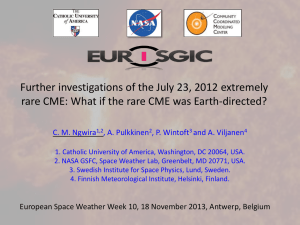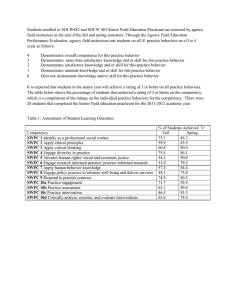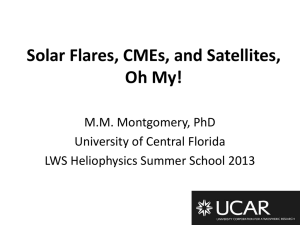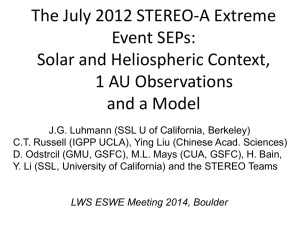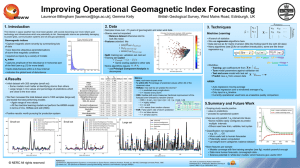PPT
advertisement
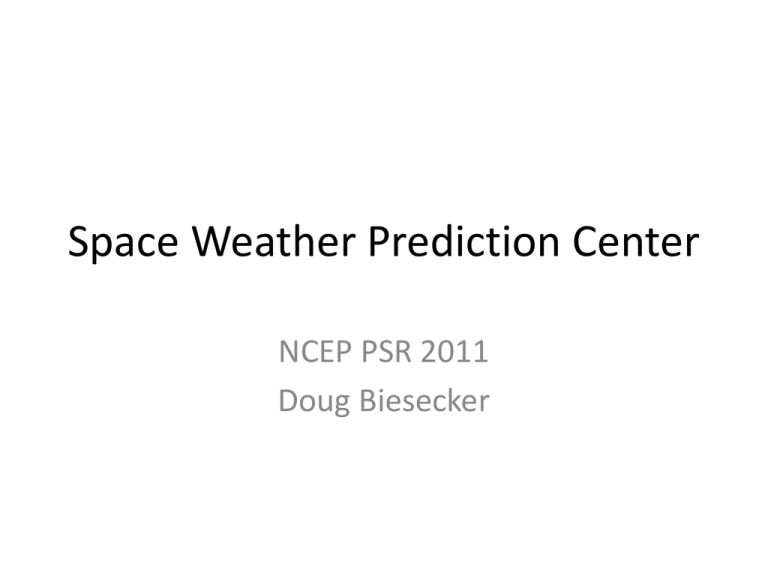
Space Weather Prediction Center NCEP PSR 2011 Doug Biesecker Outline • SWPC’s GPRA and Geomagnetic Storms • The first Operational SWx Model – WSA-Enlil • What’s coming next? – Geospace Modelling – Whole Atmosphere Modelling SWPC’s Proposed GPRA • Geomagnetic Storm Forecast Accuracy – Percentage of geomagnetic storms occurring for which a forecast was successfully issued • Storms equal to or exceeding the Minor Storming level as defined by the Daily Geomagnetic A-index ≥ 30 – equivalent to ≥ G1 Level on the NOAA Space Weather Scales. – Solar Cycle 23 (5/1996 – 12/2008) GPRA accuracy was 30% – Statistics are tracked for last 30 A ≥ 30 storms • (10/14/2003-10/31/2011) FY11 Target GPRA POD Goals FY12 Target FY13 Target FY14 Target FY15 Target FY16 Target 30% 40% 40% 45% 50% 50% FAR=70% FAR=60% FAR=60% FAR=55% FAR=50% FAR=50% POD Actual 38% FAR=63% 3 The Geomagnetic Storm SWx Scale Geomagnetic Storm Impacts Impacts from geomagnetic storms are wide-ranging with potentially significant consequences. Satellite Operations Loss of mission, reduction in capability Manned Spaceflight Increased radiation risk GPS Precision Agriculture, Surveying, Drilling, Military Power Grid Operations Grid failure, Grid capacity, Component Failure, GPS Timing Aircraft Operations Polar Flights, WAAS, NextGen, Airline Communication 5 SWPC Customer Growth is Accelerating 140 21000 20000 19000 18000 17000 16000 15000 14000 13000 12000 11000 10000 9000 8000 7000 6000 5000 4000 3000 2000 1000 0 Sunspot Number 120 100 80 60 Start of Subscription Service 40 20 0 Customers Solar Cycle Number of Customers Customer Growth SWPC Product Subscription Service WSA-Enlil Improves Geomagnetic Storm Prediction • Accepted in FOC Dec 5, 2011? • Provides perspective on corotating structures 1-27 days in advance, CME’s 1-4 days • Reduces error in geomagnetic storm onset time from ±12 hrs to ±6 hrs • Reason for early GPRA success? 7 The Results EVENT START Shock at ACE WSA/ENLIL NOAA DIFF 02/13/2011 01:44 02/18/2011 00:49 02/17/2011 15:00 9:49 03/08/2011 20:14 03/10/2011 06:10 03/10/2011 08:00 1:50 06/02/2011 07:57 06/04/2011 19:58 06/04/2011 08:00 11:58 06/21/2011 03:25 06/23/2011 02:26 06/23/2011 12:00 9:34 08/02/2011 06:19 08/05/2011 17:22 08/05/2011 17:00 0:22 09/06/2011 00:00 09/09/2011 11:49 09/09/2011 17:00 5:11 09/14/2011 02:00 09/17/2011 02:56 09/16/2011 21:00 5:56 09/24/2011 10:00 09/26/2011 11:53 09/26/2011 16:00 4:07 10/01/2011 00:00 10/05/2011 06:47 10/05/2011 16:00 9:13 10/26/2011 10:00 10/30/2011 08:55 10/30/2011 10:00 1:05 11/09/2011 13:54 11/12/2011 05:30 11/12/2011 02:00 3:30 11/26/2011 08:00 11/28/2011 21:15 11/29/2011 12:00 14:45 AVERAGE ERROR 6:26 RMS ERROR 7:48 ‘Average error’ is calculated as ‘average absolute error’, which was used by CCMC in Taktakishvili et al. 2010. ‘RMS error’ is the community preferred measure. The ‘community’ accepted error during Solar Cycle 23 is ±12 to ±15 hours 8 Enlil CONOPS NSO NASA Archive outputs GONG data SOHO LASCO data SWFO Ambient & CME inputs SWFO Monitor CME event STEREO data NGDC Name CME Generate CME cone data Forecast products Customers Process model results NCEP CCS Model results Generate graphical products Inform improved forecast WSA-Enlil model run NASA 9 WSA-Enlil run schematic CME’s are parameterized as a simple ‘cone’ CME 1 10 day model startup T = -15 CME 2 5 days CME injection forecast T=0 T = 5 days 1.5 hours Wallclock time on NWS CCS 10 WSA-Enlil production run cycle at NCO model runs every 2 hours Preprocessed GONG data Preprocessed GONG data Preprocessed GONG data Preprocessed GONG data WSA WSA CME Detected WSA WSA CME Cone Data Enlil 00Z Enlil 02Z Enlil with CME 04Z Enlil 06Z 11 Inputs drive the performance • ENLIL propagates CME’s from the corona out to Earth – Driven by the empirical WSA-Model • WSA errors in wind speed of 50-100 km/s are common • WSA errors in background wind speed of order 100km/s can change arrival time by up to 6 hours – Driven by the parameterization of Coronal Mass Ejections observed in near-real-time • An educated guess would be the CME parameter estimates are good to no better than 20% • 20% error in CME parameters can change arrival time by more than 6 hours • This is where SWPC efforts will be devoted in FY12 and likely beyond 12 WSA-Enlil in action 13 One of the better results 0:22 1:05 14 Today’s Forecast “The forecast is for rain, somewhere on Earth, sometime today.” www.ruralwellbeing.org.uk/ images/weatherman.gif Is this an analogy to geomagnetic disturbance products today? Perhaps a slight exaggeration, nevertheless there is a need for regional forecasts with longer lead time. 15 Geospace Model Transition Geospace Models Protecting Power Grids (and other services) Howard Singer NOAA Space Weather Prediction Center Safeguarding Our Nation’s Advanced Technologies Regional Geomagnetic Activity Prediction • Need for both continuous activity prediction and storm prediction (location, onset time, duration, magnitude, probability of exceeding threshold) • Focus on dB/dt and Kp • • dB/dt: demonstrated customer need (e.g. power utilities) Regional K: to serve customers and demonstrate improvement over current global products 17 Secondary Geomagnetic Activity Products and Metrics MHD Model Auroral Products Latitude, width, local time, and intensity of the auroral electrojets Related to locations of large dB/dt’s Related to location of HF radio absorption Provides location of polar cap where Solar Energetic Particle’s have access and can disrupt HF radio communication Energetic particle precipitation Metrics need to be developed Potential data sources for comparison include: AMPERE, DMSP, POES, ground-based magnetometers Polar Visible Aurora: High Solar Wind Conditions on April 17, 1999 over the North Pole Geosynchronous orbit magnetopause crossing Ionosphere: products and disturbances; e.g TEC Models at CCMC Participating in Geospace Evaluation MHD Models: 1. Space Weather Modeling Framework (SWMF) - U. of Michigan (delivered to CCMC) 2. The Open Geospace General Circulation Model (Open GGCM) - University of New Hampshire (delivered to CCMC) 3. Coupled Magnetosphere-Ionosphere-Thermosphere (CMIT) - BU CISM, Dartmouth, NCAR (delivered to CCMC) 4. Grand Unified Magnetosphere-Ionosphere Coupling Simulation (GUMICS) Finnish Meteorological Institute (recently parallelized, not ready for full evaluation for selection process) Empirical Models: 5. Weimer Empirical Model, Va. Tech (delivered to CCMC/may update) 6. Weigel Empirical Model, George Mason (delivered to CCMC) 19 SOLAR WIND – INDUCED ELECTRIC CURRENTS FLOWING IN THE MAGNETOSPHERE Credit: Kivelson and Russell, Introduction to Space Physics 20 Geospace Model Transition: Recent Activities and Current Schedule • 4/25/11: Geospace modeler meeting focused on evaluation metrics, selection process and initiate discussion to understand resource requirements • May-June 2011: Spatial, temporal, and window sensitivity testing at CCMC to refine and iterate on metrics, event selection, verification measures • June 26 – July 1 2011: GEM-CEDAR Workshop including Modeling Challenges and discussions with modelers on sensitivity tests and schedule • July – Nov 2011 : Empirical model tests, gathering data for additional events, tool to integrate currents, comparisons of db/dt calculated by CCMC and modelers (SWMF and GGCM) • Dec: Presentations and discussions with modelers at Metrics and Validation Session at Geospace Modeling Workshop (day before AGU meeting) • Jan 2012: Runs and post processing • Feb – March 2012: Analysis and Report Writing • April-May 2012: SWPC circulate draft report for comments • June 2012 : Model Selection at SWPC (I suppose this is now a choice for Louis?) 21 Geospace Model Plans • FY11 Model Selection – Metrics – Community wide testing • Mid-FY12 Begin Transition • FY15 Begin Operations Computational Requirements • Models under consideration run in real-time or near-real time on 64 processors • This configuration used for model evaluation • Detailed conops will be developed during FY12 • Current vision includes: • Porting codes to NCEP research computer and testing in configurations used during evaluation period. • Test runs using 64 processors for several intervals of solar wind conditions of up to 2-week duration • Input and output data have 1-minute time resolution; however, time steps can be on the order of 5 seconds • Codes produce on the order of 100 Gbytes/day output (it will not be necessary to store the entire output data stream, although details need to be worked.) • Test models on different types of events: 64 processors, for 2 to 3 day runs • Test models with different resolutions and code settings: 128 processors, for 2 to 3 day runs 23 Input for Geospace • NASA/ACE Satellite at L1 – Upstream of Earth 1 million miles • 15-60 minutes – Solar wind velocity, density and magnetic field – WSA/ENLIL can provide 2.5/3 inputs • Hoped for NOAA replacement (DSCOVR (Triana)) in FY11 Budget Now for a right turn… • Space Weather meets Terrestrial Weather – Where? • At 60km – Why? • To better describe the ionosphere – GPS – Communications – Satellite Drag Integrated Dynamics in Earth’s Atmosphere (IDEA) Whole Atmosphere Model (WAM) • Collaborators – NCEP Environmental Modeling Center (EMC) – Naval Research Laboratory (NRL) – National Center for Atmospheric Research (NCAR) – Others • Sponsored by – AFOSR Multidisciplinary University Research Initiative (MURI) program – NASA Living With a Star (LWS) and Heliophysics Theory programs WAM = Extended GFS Team: R. Akmaev, F. Wu, T. J. Fuller-Rowell, H. Wang 26 The advantage of Whole Atmosphere Modelling • The Whole Atmosphere Model (WAM) is an extension of the operational Global Forecast System (GFS) model currently used operationally – The operational version of this model is run four times a day but is limited to 60 km. • The WAM, currently under development for space weather, is an extension of GFS up to 600 km with additional atmospheric chemistry and dynamics appropriate for the upper atmosphere. – The WAM has been tested and validated at low spatial resolution and has shown great promise in capturing many space weather features and phenomena critical to GPS users, satellite drag/ orbit prediction, and satellite communication – Vertically extended models and data assimilation systems have also been shown to benefit conventional weather prediction by removing artificial boundaries and eliminating the limitations of existing operational systems by better specification of upper layers through which the weather satellites observe the lower atmosphere. The basic tasks • There are three critical research areas that need to be addressed: – (1) the development and implementation of the Ionosphere-Plasmasphere-Electrodynamics (IPE) module – (2) understanding the impact of increasing spatial resolution of the model – (3) implementation and testing of new data assimilation techniques applicable to the middle and upper atmospheres and ionosphere. • These activities will help in the assessment and understanding of the impact of the lower atmosphere on the structure and irregularities of the ionosphere. Funding in FY12(13?) • $800K to the National Weather Service, NCEP Central Operations – for additional computation resources (CPU and disk) – allowing WAM to be run at higher spatial/temporal resolution which would resolve waves and structures propagating from the troposphere which are critical for initiating ionospheric structures and scintillation • $400K to NCEP/EMC – to support the development of Ionosphere Plasmasphere Electrodynamics module and the integration of IPE into GFS/WAM. The IPE module adds additional physics related to the ionized component of the upper atmosphere. The neutral and ionized components are highly coupled and both are critical to the full representation of them ionospheric gradients and irregularities • $800K to SWPC – to develop data assimilation techniques for satellite data above 60 km. There are several assimilation techniques (Kalman Filter, 3-D-VAR, 4-D-VAR, etc) which have strengths and weaknesses at various altitudes in the atmosphere. These techniques need to be implemented, explored, and evaluated. – to support evaluation of the model improvements and validation and verification of the results of each of these improvements (higher resolution, IPE module, and data assimilation) data being implemented into WAM. • The application of these additional resources will accelerate the model development by at least two years. Computational Requirements • WAM estimate for annual computer requirement for 2012 on NCEP machines. – The first 6 months on vapor, the following 6 months presumably on the new SGI machine, zeus. If there is a delay in porting WAM to zeus it could impact the expected usage. – Total requirement, all projects: 34050 node-hours, or ~4250 hours on 8 nodes, or roughly 8 nodes 50% of the time. Margin of error 50%. – Disk space requirements ~30 TB for 2012. • 2013-2015 usages are estimate to increase by a factor of two per year. Future Plans • Space Weather has come into numerical prediction in a small way in FY12 with WSAEnlil – Bringing a dramatic improvement in prediction of geomagnetic storms • FY12-15 will see a large increase in SWPC needs for computational resources – Geospace and WAM modeling will bring dramatic new capabilities that will benefit many areas of space weather 31
